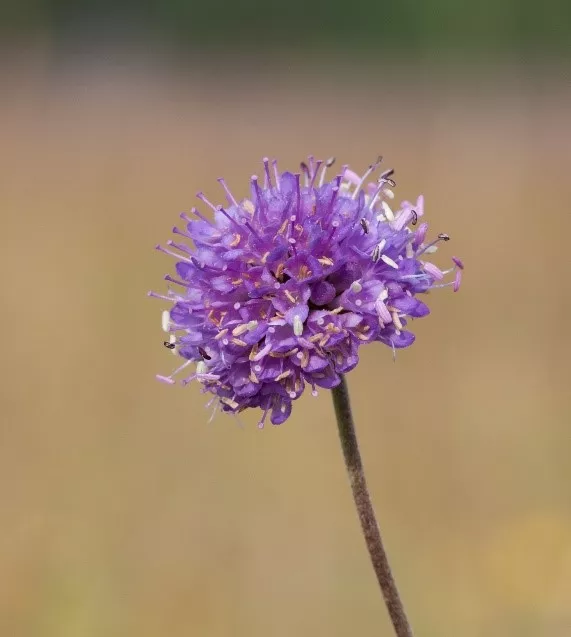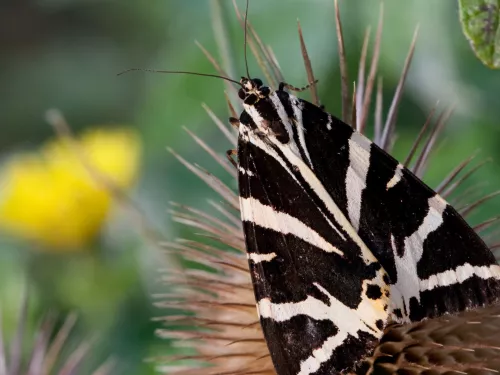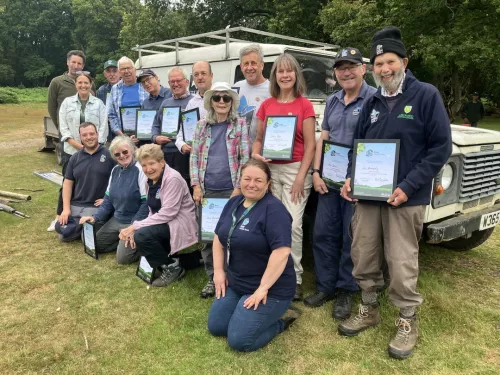
Meet the herd – the eight wild bison on a wilding journey in Canterbury
Since bison were released into West Blean and Thornden Woods on the outskirts of Canterbury, they have not only transformed the landscape but significantly grown in number.


Devil's-bit scabious, Succisa Pratensis © Vaughn Matthews
This lovely perennial is in the teasel family, Dipsacaceae. It needs poor soil to flower well, so in a garden does best in a meadow in impoverished soil, where it can drop seed before an autumn cut. There are named varieties, and another scabious, Knautia macedonica, tolerates border conditions better, but still prefers no cossetting.
All the names are from the Latin: Scabious from scabere, to scratch, (hence scabs) as it was used for treating scabies and bubonic plague sores. Succisa means to cut off below, describing the truncated rootstock; John Parkinson in his Theatrum Botanicum of 1640, wrote that the Devil was jealous of the plant’s healing power so bit the end off its root. Pratensis means of the meadows.
Devil’s-bit scabious is the foodplant of the endangered marsh fritillary butterfly, Eurodryas aurinia, now limited to the west of the UK due to major habitat loss. Recent winged sightings here include southern and migrant hawkers (dragonflies) speckled wood, gatekeeper, comma, holly blue, common blue, meadow brown, brimstone, clouded yellow, brown argus and small copper butterflies and parasitic ruby tailed wasps, a favourite of staffer Lucy Carden.
To everyone’s delight, livestock checkers, solo survey and the green team volunteers are back, working within Kent Wildlife Trust guidelines and enabling Kent Wildlife Trust staff to return to other tasks. Soon after restarting, volunteer Les Kennedy said “Sometimes we freeze in the cold and others we bake in the sun. Sometimes we get soaked or snowed on but then we see the end result and it makes everything worthwhile.”
A message from Kent Wildlife Trust
Hothfield Heathland is open to everyone; trails are signposted and marked on entrance maps, along with the location of livestock. Please keep dogs in check, especially around children and livestock, and keep them away from the heather and undergrowth where they will disturb sensitive wildlife. Please remove dog mess, including in the Triangle compartment. For email alerts on the location of the livestock on Hothfield contact Cristina Juan at cristina.juan@kentwildlife.org.uk or 01622 662012.

Since bison were released into West Blean and Thornden Woods on the outskirts of Canterbury, they have not only transformed the landscape but significantly grown in number.

Margery Thomas, Hothfield Volunteer and regular columnist looks at the lack of butterfly sightings in recent months, the work volunteers are doing to remove bracken and how this all impact the wider management of the last remaining fragments of heathland…

By August, floral glory has passed from the orchids (heath spotted, southern marsh and a few large hybrids) to the heather or ling. As ever, we hope for a protracted display of purple in the heathy areas, which is likely if the cool nights persist. Orchid…